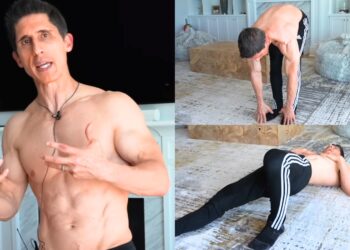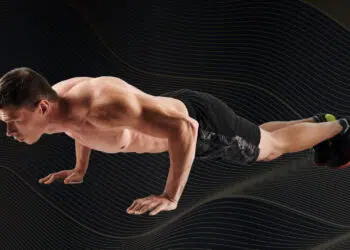Cats, dogs, and many other animals are habitual stretchers. In fact, some human stretches are named after animals – such as the cat stretch and downward dog from yoga. Animals stretch instinctively and regularly, so they are always ready for action. Lions don’t need to warm up before chasing down their prey!
However, humans are, by and large, much more sedentary and spend a lot of time in fixed positions, e.g., seated. This causes muscles to tighten, which is a process called adaptive shortening. As such, most people need to spend time warming up to get their muscles ready to work.
Regular stretching, i.e., several times a day, can help keep you loose and limber, so, like an animal, you are always ready to move.
Try setting the alarm on your phone and doing a couple of stretches every hour or so. I guarantee that, in a week or two, your body will feel much more mobile, and you won’t need to spend so much time warming up for your workouts.
But, did you know there are several different ways to stretch and that each one has benefits and drawbacks?
Like all forms of exercise, when it comes to getting results from your workouts, specificity matters, so you need to choose the right type of stretching for your goals.
Level Up Your Fitness: Join our 💪 strong community in Fitness Volt Newsletter. Get daily inspiration, expert-backed workouts, nutrition tips, the latest in strength sports, and the support you need to reach your goals. Subscribe for free!
In this article, we look at ballistic stretching so you can determine if that’s the right flexibility training method for you.
What is Ballistic Stretching?
When most people think about stretching, they often imagine doing slow or static movements that take their muscles into an extended position.
For example, if you want to stretch your hamstrings, you could sit on the floor with your legs straight in front of you and then reach down toward your toes, holding this position for 30-60 seconds. This is a static stretch.
In contrast, ballistic stretches involve faster, more dynamic movements, and the target muscle is stretched repetitively but very briefly. Where static stretches are held for time, ballistic stretches are usually done for reps.
Using the hamstrings as an example again, you could ballistically stretch your hamstrings by doing alternating front kicks, with each one taking your hammies to full extension.
Here’s an example of an alternating leg ballistic hamstring stretch:
Most standard stretching exercises can be done statically OR ballistically. To do a ballistic stretch, you simply move into and out of the stretched position quickly. This may involve a large range of motion or more of a bouncing movement and a shorter range of motion.
In most cases, you should try and stretch a little further, rep by rep. If you do several sets, your range of motion should gradually increase.
Benefits of Ballistic Stretching
Ballistic stretching is often used in sports, especially by gymnasts and martial artists. It’s also common in forms of dance. They use it because it works! The primary benefits of ballistic stretching include:
Increased flexibility and range of motion
Ballistic stretches use momentum to extend your muscles beyond their normal range of motion. This can lead to rapid increases in flexibility (1).
Increased strength
Many ballistic stretches involve using your antagonist muscles powerfully. For example, in an alternating leg front kick for the hamstrings, you must use your quads and hip flexors to raise your legs.
This not only increases long-term strength but also helps fire up these muscles for a more productive workout (2). Ballistic stretches also enhance the stretch-shortening reflex, which is an important aspect of force generation.
Replicates the demands of many sports
A lot of sports involve ballistic movements. For example, kicking a soccer ball is a perfect example of ballistic stretching in action. After all, you kick the ball with a) lots of power and speed and b) by taking your hip through a large range of movement.
Your foot might connect with the ball low down, but then momentum means your leg continues swinging upward, talking your hamstrings into a stretched position.
It’s often said that you should train how you compete. This is the law of specificity. As such, if your sport involves ballistic movements, you should probably include ballistic stretches in your workouts. Failure to do so could mean that, when you come to perform the skills of your sport for real, you hurt yourself because you haven’t trained specifically enough.
The same is true for activities outside of sports. For example, we often need to extend our muscles quickly, such as bending down to pick something off the floor or catching a falling object. Every powerful action starts and ends with a rapid stretch.
Try throwing a ball without pulling your arm back first and then following through to full arm and shoulder extension. Both are examples of ballistic stretching.
Improved tendon elasticity
Your muscles are attached to your bones via tendons. Tendons are inelastic fibrous tissues that are also very strong. Studies suggest that ballistic stretching can improve tendon elasticity, which may decrease the risk of acute injury (3).
While tendons will never be as elastic as muscles, even small increases in tendon elasticity can reduce the risk of tendon injuries. Tendons have a poor blood supply which means they heal very slowly. As such, any increase in tendon elasticity can be beneficial, especially in explosive sports like sprinting and basketball, where tendon injuries are common.
Ballistic Stretching Drawbacks
While there are several advantages and benefits to ballistic stretching, there are downsides, too. Reasons to think twice about doing ballistic stretches include:
Level Up Your Fitness: Join our 💪 strong community in Fitness Volt Newsletter. Get daily inspiration, expert-backed workouts, nutrition tips, the latest in strength sports, and the support you need to reach your goals. Subscribe for free!
Risk of muscle, tendon, and ligament injury
Rapidly stretching a muscle could take your joints far beyond their normal range of motion. This could lead to overstretching and tissue tears. The joint itself could even become damaged.
Because of this, you should always warm up before ballistic stretches and gradually increase your range of motion over several sets. For example, jumping straight into full-power ballistic stretches while your muscles are cold could cause serious injury.
Not suitable for beginners or deconditioned people
While ballistic stretching is useful in developing flexibility, performing ballistic stretches requires plenty of strength. Strength is needed at the start of each rep to initiate the movement and at the end to “put on the brakes” and prevent hyperextension.
As such, this type of stretching is best left to well-conditioned individuals with the necessary strength to perform the exercises correctly and safely.
Sports and activity specificity
A lot of people simply do not need to spend a lot of time and energy on ballistic stretching, as it’s not specific to their training goals.
Ballistic stretching makes a lot of sense if you are a martial artist training to do better head kicks. But, if you are a recreational runner who seldom uses a large range of motion, the risks probably outweigh the benefits, and ballistic stretching is not a good use of your time or energy.
When choosing any exercise or type of training, you should always compare the cost to the reward. For most recreational exercisers, the potential cost of ballistic stretching (injuries) far outweighs the rewards.
Other types of Stretching
Whether you choose to include ballistic stretching in your workouts or skip it entirely, there are other types of stretching that may also be helpful. The main types of stretching are:
Static stretching
Static stretching involves easing into a stretched position and then holding it for a set time, e.g., 20-60+ seconds. The longer you hold a stretch, the more the target muscle will relax, and the bigger your range of motion will be.
Short stretches of 10-20 seconds are called preparatory or maintenance stretches. In contrast, stretches held for 60 seconds or more are known as developmental stretches. Developmental stretches are best for improving your flexibility.
However, developmental stretches are not ideal for warm-ups because they make your muscles relax. Instead, they are better suited for use during cool-downs or on non-training days.
Example static hamstring stretch:
Dynamic stretches
Dynamic stretches are similar to ballistic stretches, but they are performed more slowly and don’t take your limbs through such an extensive range of motion. Dynamic stretches are ideal for warm-ups as they increase functional flexibility without causing the muscles to relax.
Dynamic stretches include shallow progressing to deeper lunges and squats.
Example dynamic hamstring stretch:
PNF
Short for proprioceptive neuromuscular facilitation, PNF works on the theory that a muscle is more receptive to stretching after a contraction.
There are several types of PNF stretching, some of which include using the opposing muscle to facilitate the stretch. This is called CRAC stretching, which is short for Contract Relax Agonist Contract.
To do a simple PNF hamstring stretch:
- Lie on the floor with one leg bent and one leg straight. Raise your straight leg and loop a yoga strap over your foot. Pull your leg into a stretched position and hold for 15-20 seconds.
- Without lowering your leg, push it into the strap to generate tension in your hamstrings. Hold for 10-15 seconds, and then relax.
- Use the strap to pull you into a deeper stretch. You can also use your quads and hip flexors to pull your leg up (CRAC).
- Hold the stretch for a further 15-20 seconds, and then repeat the contract/relax cycle several more times.
- Stop when you are no longer able to increase your range of motion.
PNF stretches can also be done with the aid of a partner:
Ballistic Stretching – Wrapping Up
While ballistic stretching is a valid form of flexibility training, it’s not suitable for everyone. If you are involved in a sport that uses a lot of rapid, full-range movements, it makes sense to do ballistic stretching as it’s what you’ll be doing in practice and competition. You should always try to train in a way that mirrors the demands of your chosen activity.
However, suppose you are a recreational exerciser or do sports that do not involve large and explosive movements. In that case, ballistic stretching may be unnecessary, and the risk of injury could outweigh the benefits.
If you DO decide to include ballistic stretches in your workouts, always prepare your muscles and joints with some light cardio, joint mobility, and dynamic stretches. Muscles stretch best when they are warm.
Then, when you start stretching ballistically, increase speed, power, and range of movement gradually over a couple of sets. Going too hard too soon is a good way to get injured.
Finally, developmental static stretches are arguably the way to go if you want to improve your flexibility. There is minimal risk of injury, and they’re very easy on your joints, too. Plus, static stretching can be very relaxing and great for reducing stress.
More Stretches:
- Don’t Just Sit There! 8 Useful Things to Do Between Sets in The Gym
- Essential 6-Minute Stretching Sequence for Immediate Muscle Relief
- Partner-Assisted Stretching: Just Lazy or the Key to Optimizing Your Flexibility?
- Age-Proof Your Body: The Ultimate Guide to Exercises That Prevent Mobility and Muscle Loss
- Unlock Your Hip Flexors: Assisted Prone Lying Quads Stretch Guide
- 10 Best Abs Stretches to Improve Flexibility
- Say Goodbye to Stretching: Relieve Upper Body Tension with This 10-Minute Foam Rolling Routine
- How a 2-Minute Hanging Habit Transforms Your Body (Science Explained)
- 5 Life-Changing Stretches for People Who Sit All Day
- Don’t Skip the Cool Down! 20 Exercises for Better Recovery and Reduced Muscle Soreness
References:
1. British Journal of Sports Medicine: A Comparative Study of Static Stretching Versus Ballistic Stretching on The Flexibility of The Hamstring Muscles of Athletes https://bjsm.bmj.com/content/44/Suppl_1/i16.2.abstract
2. PubMed: Acute Effects of Active, Ballistic, Passive, and Proprioceptive Neuromuscular Facilitation Stretching on Sprint and Vertical Jump Performance in Trained Young Soccer Players https://pubmed.ncbi.nlm.nih.gov/29084092/
3. PubMed: Effects of Acute Static, Ballistic, And PNF Stretching Exercise on The Muscle and Tendon Tissue Properties https://pubmed.ncbi.nlm.nih.gov/27367916/









